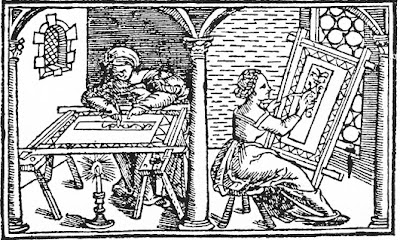One of the other prerequisites for embroidering a large tapestry is that you also need a large embroidery frame. We liked to make an embroidery frame based on historic evidence (read images) and have used the fresco Triumph of Minerva as a basis. Bram and I have made two frames from beech, because this wood does not splinter. They are wide enough to rest on two trestles, while Anne or Katinka sit between the trestles working on it. While the final trestles are not yet ready, the frames are (and are in use). We have made the frame flexible in size: the long rails can move through mortises in the short rails and fixed with pins at any size. At each end of the long rails are blocks (also with mortise and pin) holding a 'roller' where the excess linen of the (embroidered) tapestry can be wound. The long rails measure 88 x 3.5 x 1 cm; the short rails are 70 x 3.5 x 3.5 cm. The current workspace of the frame, measured from the rows of holes is 68 x 58 cm. The holes (for tensioning the canvas) have a diameter of 2.5 mm and are 1 cm apart from each other. The complete frame was waxed afterwards.
The unwaxed embroidery frame with the linen canvas loosely fitted over it. Only one of the side rollers is attached here.
Detail of the mortise with pin.
With the frame ready, the linen had to be tensioned on the frame. As our tapestry is longer than our frame, the method of tensioning is slightly different from what is shown in medieval images (which show smaller embroidery pieces). We had to fix the linen to the short rails, while the remaining linen was wound on the side rollers. To protect the canvas against to much force of the tensioning threads we used a thicker thread (see photo). The long rail could be tensioned as normal.
Two embroiderers at work transferring the image to the linen. You can clearly see the way how the canvas is tensioned to the frame. Image from the book 'Embroiderers' by K. Staniland from the British Museum Press.
Preparing the tensioning of the canvas to the frame. First the short sides were fixed, then the remaining long sides.
Fixing on the short side, using an extra thick thread to protect the linen against to much force of the (black) fixation thread.
The long rail tensioned normally in a V-like manner.
 The ladies Anne and Katinka at work on the Thomasteppich in Eindhoven and Castle Doornenburg, respectively.
The ladies Anne and Katinka at work on the Thomasteppich in Eindhoven and Castle Doornenburg, respectively.Winding spools
For ease of use, we have rewound the woollen hanks onto spools. During medieval times child labour was common. Thus, our (and visiting) children were employed to wind the spools.









is it possible to buy a frame like this somewhere? I have been working on a long tapestry (depiction of the Bayeux Tapestry) and am at the point where I need a scrolling frame, one that scrolls from left to right like this one and is large enough. My tapestry is 39" x 24". Any help is appreciated.
ReplyDeleteMy Bayeux was 48", and had the same problem. I tried every type and size of hoop and scroll, frequently changing methods. I ended up using a quilting hoop and stand, and wondered why I didn't start with it. The hoop and stand allowed me to use both hands, let me relax while stitching, while seeing more of the fabric.
ReplyDelete